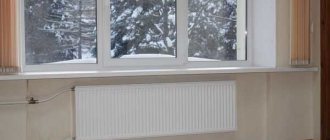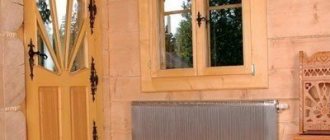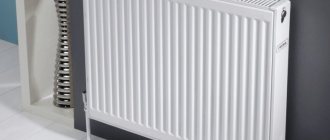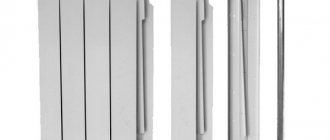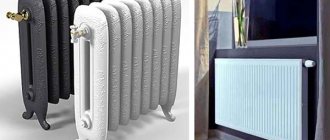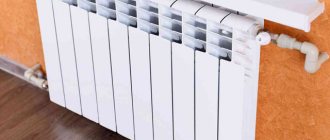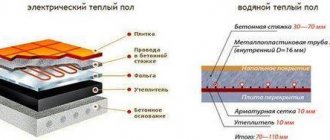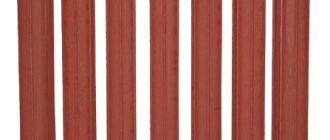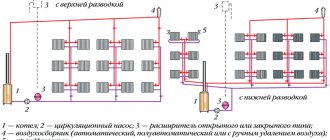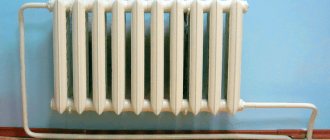Durability characteristics of heating radiators:
| Radiator type | Resistance to internal corrosion | Water hammer resistance | Average service life |
| Steel radiators | Weak | Weak durability | 15-20 years |
| Cast iron radiators | High | Medium durability | 25-35 years |
| Aluminum radiators | High | Medium durability | 20-25 years |
| Bimetallic | High | High durability | 25-30 years |
The service life and reliability of the heating radiator are among the main factors that must be taken into account when choosing heating devices. Therefore, when choosing devices to equip your heating system, you definitely need to find out how long radiators of a certain type last and what factors their durability depends on.
The average service life for radiators of various types, manufactured in accordance with GOST, is given in the table. However, their actual shelf life depends largely on the characteristics of the heating system and operating conditions.
The main external factors that affect the service life of heating radiators are:
- operating pressure of the coolant in the system;
- chemical composition of the coolant;
- coolant temperature in the system.
Also, the durability of radiators installed in apartments in apartment buildings can be greatly affected by water hammer, which occurs when the central heating system is started in the autumn.
Each of the metals from which heating devices are made has a varying degree of resistance to negative factors. Therefore, their durability and reliability indicators will be different.
Main types of radiators
Steel radiators . They are mainly used for heating residential buildings. The appearance is quite aesthetic, the price is above average, and decent heat transfer is what makes steel radiators for private homes chosen.
Bimetallic radiators . They are widely used in the construction industry. The quality to price ratio is acceptable. A distinctive feature is the use of a steel tube in an aluminum housing. Can be used in central heating.
Cast iron radiators . The oldest type of heating radiators. Their shape is simple and strict, the façade is smooth, and the design is restrained. They take a long time to heat up, but are ideal for systems with central heating. They are durable, inexpensive, and last about 50 years.
Aluminum radiators . They stand out for their beautiful appearance. However, this type of heating radiator is not the best option for use in a living space where there is a central heating system. But in living spaces with an autonomous heating system, this type of radiator is considered quite well known. In addition to their elegant appearance, they are distinguished by reliability, as well as a long service life - about 25 years.
Copper-aluminum radiators . They have high heat transfer. They are often installed in apartments, offices and similar premises. Corrosion resistant.
conclusions
It is impossible to say unequivocally what will be better: panel or tubular heating radiators. Both devices have proven their effectiveness in heating homes. However, if we compare these devices in terms of heat transfer and versatility with a slight advantage, we would give preference to tubular batteries.
Did you find this article helpful? Please share it on social networks: Don't forget to bookmark the Nedvio website. We talk about construction, renovation, and country real estate in an interesting, useful and understandable way.
Panel View
Steel panel radiators are often called convectors. It consists of one/several heating panels, convector fins, connection pipes, channels for coolant, and a grille.
A fairly economical choice for use in a private home, it is widely used for rooms with autonomous heat supply.
Types of steel batteries
Divided into types depending on the number of heating panels and convectors. Type 11 - consists of one row of panels, a convector, and does not have a grille on top. Often used to equip corridors and toilets. Type 22 - has two panels, a convector, a casing. With relatively small dimensions it has good thermal power. Type 33 - three panels, convectors, the casing is closed.
Selection
Heat output varies between 200 and 1800 Watt and more. Depends on the size of the radiator, brand and model. Their inertia is small. They heat up quickly and transfer heat to the room. Working pressure is about 7-10 atmospheres. Highly susceptible to corrosion. Withstands water temperatures up to 120 degrees. Length is about three meters, height from 25 to 85 centimeters. The thickness of the steel depends on the manufacturer, usually from 1.1 to 1.2 mm. They are durable due to their material; the thicker the walls, the longer the radiator will last. Their installation is quite simple and convenient.
Connection types
Lower . The coolant passes into the lower lobe of the radiator. Warm coolants are lighter than cool ones, as a result of which it rises upward, displacing the cooled coolant. Then the cooled one drops into the lower horizontal radiator manifold. Heat costs will be approximately 15-20% depending on various factors.
Upper . The coolant moves along the upper part of the radiator, but must go down due to the plug, then rise up along the pastel section and flow out of the radiator on the other side. Thus, the coolant flows through the entire radiator structure, and it heats up completely.
Lateral . When this is turned on, coolant enters the upper lobe of the radiator, after which it descends down the vertical channel of the radiator and exits through the lower manifold through the side from which the radiator was connected. However, every coolant moves along the path of least resistance. A huge portion of the coolant will begin to flow through the first sections. As a result, the greater the number of sections of the radiator, the lower the heating temperature will be for the last sections. This will affect the combined heat loss of the radiator.
Diagonal connection . The coolant is supplied through the top of the radiator, which is horizontal to the floor. Then it flows down through vertical pipes, enters the bottom of the radiator and exits in the other direction. This way the radiator heats up completely, each section heats approximately identically well.
Specifications
Steel home heating radiators consist of two plates connected by welding. Due to this connection, the space necessary for free circulation of the coolant is created inside, while the welds securely hold the plates. The steel from which panel-type radiators are made is exposed to rust due to contact with the heat carrier, which provokes its gradual wear, reaching 0.1 mm per year. To reduce this indicator, batteries are coated with paint using cathodic or anodic electrophoresis or the immersion method.
In accordance with technical calculations and characteristics, panel batteries are divided into several types, taking into account the number of heat exchangers and the number of panels. Their service life is quite long if the temperature during operation of the coolant remains at around 70 degrees. It must be remembered that the maximum temperature of the liquid inside the system should not be higher than 100 degrees. The operating pressure during installation cannot exceed 10 bar to avoid emergency situations.
Advantages and disadvantages
- environmentally friendly, do not cause harm (due to this they can be used in clinics, schools, etc.);
- small volume of coolant and energy consumption;
- high heat transfer;
- aesthetic appearance;
- convenient to install;
Among the disadvantages:
- drafts may occur and dust may rise due to convection;
- high risk of damage due to water hammer; use in high-rise buildings is not possible;
- paint may peel off;
- the appearance of corrosion when draining water from the radiator.
- inferior in price to many radiators
Why don't they warm up?
It is extremely unpleasant at the height of the winter season to face the fact that either the whole or part of the heating system is cold. To figure out why the heating radiator in the apartment does not heat, the reasons need to be looked for in what is preventing the flow of coolant into the system.
There are only a few of them:
You can eliminate some of the reasons yourself, for example, remove the air lock.
The heating battery in the apartment has burst - what to do:
- If there is a circulation pump, it must be turned off
to relieve excess pressure on the system. - Open the Mayevsky tap
, and if there is none, then
remove the plugs from the battery
. - These actions will cause air to escape from the system
, which occurs with a characteristic hissing sound. - After water flows from an open tap, turn it off.
It is necessary to prepare containers for the coolant in advance and wait until the whistling from the system stops completely. After some time, you can check the radiators for the presence of heat - if they are hot, then everything is done correctly.
If the reason that the radiators do not heat is a lack of coolant, then such work should not be carried out independently, without having the appropriate experience. When water enters the system, air pockets can form. If the system is clogged, it should also be entrusted to the experts, since this will require removing it for cleaning or completely replacing its damaged areas.
Tubular view
They look like a standard structure of pipes and steel through which high-temperature water flows. Their production costs are higher, so the price is higher than that of panel radiators. Fairly low water pH - from 8 to 9. Withstands pressure from 9 to 14 bar. Thermal power is 1300 to 1500 Watt.
Tubular steel radiators have similar pros and cons to panel radiators. However, there are two different indicators: they withstand more pressure and are more expensive.
Repair of heating batteries in an apartment
The main question that arises when there are problems with heating in an apartment is where to go and who will pay for the repairs.
Since problems with radiators, especially outdated ones, happen frequently, so do legal “skirmishes” between residents and utility services. Representatives of the housing office each time claimed that they were in charge only of that part of the heating system that was located in the entrance, while the owners of the affected apartments proved the opposite.
This was the case until the law on communal property was adopted, according to which the entire heating system, even that located in private apartments, is under the jurisdiction of public utilities. To ensure that all radiators work efficiently, the masters of the organization providing heat
, and the residents of the house contribute money monthly for major repairs of the heating system in an apartment building, if necessary.
The heating in the apartment is not working, who should I call? For any problems with the system, you need to call the appropriate service and its representatives will fix them free of charge.
This does not apply to cases where the heating is in order, and the residents decide to change the radiators to a newer model. In this case, the entire replacement occurs at the expense of the apartment owners.
When a heating radiator leaks in an apartment, this is caused by the following reasons:
To independently fix a broken heating battery in an apartment, which is usually not recommended, you can use epoxy resin-based glue, but only as a temporary solution to the problem until the emergency service arrives.
If the cause of the leak is a dried out gasket, then you can replace it yourself, provided that there is no water in the system. If the accident occurred during the heating season, then in order to avoid burns it is better not to do anything on your own.
As can be seen from the above, in order not to wait for extreme cases, you need to monitor the heating system, and if it does not heat, makes strange sounds or leaks, then you should call the housing office or emergency service.
If the radiators have long expired, there is no need to check them for durability, but replace them with a more modern model that matches the parameters.
Installation of a heating system is an investment in warmth, coziness and comfortable living. That is why special attention must be paid to the choice of batteries. The longevity of operation depends on the correct choice of batteries. That is why the main criterion that you should pay attention to before purchasing is the service life of heating radiators.
Main manufacturers
One of the most famous manufacturers of steel panel radiators is Kermi , Germany. The quality of the products is high, and special technologies are used to create them that increase the heat transfer factor. Thanks to the two innovations "Therm X2" and the valve adjustment, approximately 10% energy is saved in advance. The range includes radiators with bottom and side connections. Available in popular types 11, 22 and 33.
Buderus , Germany. They are used mainly for heating houses and other buildings where the coolant temperature is no more than 110 degrees. Lengths of versions from 400 to 2900 mm, heights from 350 to 850 mm. After delivery, the radiators are completely ready for installation. Can be installed in systems with pressures up to approximately 9 bar.
Korado , Czech Republic. Their main part is a pair of plates, which represent a heating surface. The company has a wide range of models, so a person can easily choose the steel panel heating radiator he needs. Wall thickness more than 1.15 mm. It is used as a coolant for water/aqueous substances with temperatures up to 109 degrees Celsius. You can conceal the installation of pipes.
DeLonghi , Italy. They operate silently, there are no exposed heating parts, and the rooms are heated evenly. The manufacturer guarantees the safety and reliability of the products.
PURMO , Finland. Finnish steel radiators are gaining more and more popularity in our country. After all, due to affordable prices, domestic manufacturers are not particularly represented on the heating appliances market. The price/quality ratio pleases customers; a variety of sizes and types of radiators makes it possible to choose a heating device for your place of residence, office, or other building. Reviews speak of a long service life, pleasant appearance, and high performance of the device. Also a plus is the fact that the manufacturer produces radiators not only in white, but also in black, red, and so on. You can choose a custom color. Made from low carbon steel. There are 4 types of connections possible - side, saddle, diagonal, bottom.
Among the manufacturers of tubular steel radiators, it is worth noting Charleston , Germany. They have a lateral connection and a columnar structure. Composed of several sections, which are connected by welding. They are used in closed systems where the radiator does not come into contact with air. It is not applicable for hot water supply. Can be used not only for residential premises, but also for administrative buildings. The steel thickness is standard, about 1.2 mm.
Arbonia , Germany. Their appearance is quite minimalistic, and you can also choose a custom color. Radiators do not take up large areas due to their small and narrow dimensions - they are tall but thin. The modern look is ideal for refreshing the design of your area. It is not like traditional batteries.
Causes of failure
If the heating system has failed not because of its “antiquity”, then you should look for a fault somewhere else.
It could be:
- The radiator does not match the system of the apartment building.
This may be due to pressure or quality of the coolant. - Flaws when connecting to pipes
, which can cause a breakthrough after a while. - Operating conditions are not suitable for this type of radiator
due to frequent pressure changes. - If the coolant is too littered
, then this causes the accumulation of suspensions at the attachment points, which in due time will lead to a leak. - Gaskets between sections also do not last forever
, and failure of one of them can compromise the integrity of the system.
The main visual sign that something is wrong with the system is an obvious leak, while internal damage, for example, airiness or contamination, can be determined by the temperature in the room.
